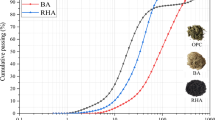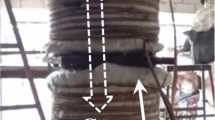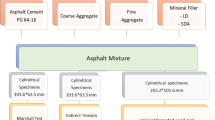Abstract
The consequences of climate change have led to electricity shortages and a rising energy crisis. The demand for alternatives to reduce energy consumption is growing rapidly. Insulation improvement using porous facade panels can reduce heat exchange, contributing to a reduction in energy expenditure. However, these conventional construction materials involve energy-intensive processes and use non-renewable resources. Alkali-activation of industrial wastes may present a viable and sustainable solution. This research evaluated the applicability of alkali-activated pastes, based on stone-cutting waste, on the core of facade panels to optimise thermal insulation. An experimental program was carried out to quantify the mechanical and thermal behaviour of alkali-activated marble and granite cutting waste. The results indicate that both wastes are viable precursors to produce facade panels in terms of strength. Regarding the thermal behaviour, as the density increased, the thermal transmission coefficient decreased. A range between 1.63 W/m2 °C and 1.97 W/m2 °C was obtained, which is lower than the thermal conductivity values shown by current insulation materials with similar density, indicating the suitability of the proposed solution for thermal insulation.














Similar content being viewed by others
References
Acevedo-Martinez E, Gomez-Zamorano LY, Escalante-Garcia JI (2012) Portland cement-blast furnace slag mortars activated using waterglass—Part 1: effect of slag replacement and alkali concentration. Constr Build Mater 37:462–469. https://doi.org/10.1016/j.conbuildmat.2012.07.041
Akturk B, Ayhan BU (2021) Utilization of waste basalt powder by alkali activation: performance and microstructure. SSRN Electron J. https://doi.org/10.2139/ssrn.3982888
Andreas J-J, Burns C, Touza J (2017) Renewable energy as a luxury? A qualitative comparative analysis of the role of the economy in the EU’s renewable energy transitions during the ‘double crisis.’ Ecol Econ 142:81–90. https://doi.org/10.1016/j.ecolecon.2017.06.011
Andrew RM (2019) Global CO2 emissions from cement production, 1928–2018. Earth Syst Sci Data. https://doi.org/10.5194/essd-2019-152
Ascensao G, Seabra MP, Aguilar JB, Labrincha JA (2017) Red mud-based geopolymers with tailored alkali diffusion properties and pH buffering ability. J Clean Prod 148:23–30. https://doi.org/10.1016/j.jclepro.2017.01.150
ASTM (2018) C349: standard test method for compressive strength of hydraulic-cement mortars (using portions of prisms broken in flexure). Am Soc Test Mater. https://doi.org/10.1520/C0349-18.2
ASTM (2021) C348: standard test method for flexural strength of hydraulic-cement mortars. Am so 03:98–100. https://doi.org/10.1520/C0348-21.2
Awang H, Mydin AO, Roslan AF (2012) Effect of additives on mechanical and thermal properties of lightweight foamed concrete. Adv Appl Sci Res 3:3326–3338
Azevedo AGS, Strecker K, Barros LA, Tonholo LF, Lombardi CT (2019) Effect of curing temperature, activator solution composition and particle size in Brazilian fly-ash based geopolymer production. Mater Res 22:1–12. https://doi.org/10.1590/1980-5373-mr-2018-0842
Bakshi P, Pappu A, Patidar R, Gupta MK, Thakur VK (2020) Transforming marble waste into high-performance, water-resistant, and thermally insulative hybrid polymer composites for environmental sustainability. Polym (basel) 12:1781. https://doi.org/10.3390/polym12081781
Batool F, Rafi MM, Bindiganavile V (2018) Microstructure and thermal conductivity of cement-based foam: a review. J Build Eng 20:696–704. https://doi.org/10.1016/j.jobe.2018.09.008
BSi 1936 (2006) BS EN 1936:2006—Natural stone test methods. Determination of real density and apparent density, and of total and open porosity. Br. Stand. Institution, London
Chen G, Li F, Geng J, Jing P, Si Z (2021) Identification, generation of autoclaved aerated concrete pore structure and simulation of its influence on thermal conductivity. Constr Build Mater 294:123572. https://doi.org/10.1016/j.conbuildmat.2021.123572
Chindaprasirt P, Rattanasak U (2011) Shrinkage behavior of structural foam lightweight concrete containing glycol compounds and fly ash. Mater Des 32:723–727. https://doi.org/10.1016/j.matdes.2010.07.036
Coppola B, Palmero P, Montanaro L, Tulliani J-M (2020) Alkali-activation of marble sludge: Influence of curing conditions and waste glass addition. J Eur Ceram Soc 40:3776–3787. https://doi.org/10.1016/j.jeurceramsoc.2019.11.068
Cristelo N, Sousa L, Sá A, Segadães L, Sampaio J (2021) INPI Process for obtaining products with thermal insulation characteristics based on ornamental rock wastes. Req. 117467
Dembovska L, Bajare D, Ducman V, Korat L, Bumanis G (2017) The use of different by-products in the production of lightweight alkali activated building materials. Constr Build Mater 135:315–322. https://doi.org/10.1016/j.conbuildmat.2017.01.005
Fleiter T, Steinbach J, Ragwitz M, Arens M, Aydemir A, Elsland R, Frassine C, Herbst A, Hirzel S, Rehfeldt M, Reuter M, Dengler J, Köhler B, Dinkel A, Bonato P, Azam N, Kalz D, Reitze F, Toro Chacon FA, Willmann P, Maliha S, Schoen M, Tuillé F, GaëtanFovez Lescot D, Hartner M, Kranzl L, Müller A, Fothuber S, Hummel M, Hiesl A, Resch G, Aichinger E, Reiter U, Catenazzi G, Jakob M, Naegeli C (2016) Mapping and analyses of the current and future (2020–2030) heating/cooling fuel deployment (fossil/renewables)
Font A, Borrachero MV, Soriano L, Monzó J, Payá J (2017) Geopolymer eco-cellular concrete (GECC) based on fluid catalytic cracking catalyst residue (FCC) with addition of recycled aluminium foil powder. J Clean Prod 168:1120–1131. https://doi.org/10.1016/j.jclepro.2017.09.110
Gao X, Yuan B, Yu QL, Brouwers HJH (2017) Characterization and application of municipal solid waste incineration (MSWI) bottom ash and waste granite powder in alkali activated slag. J Clean Prod 164:410–419. https://doi.org/10.1016/j.jclepro.2017.06.218
Hamad AJ (2014) Materials, production, properties and application of aerated lightweight concrete: review. Int J Mater Sci Eng. https://doi.org/10.12720/ijmse.2.2.152-157
Hlaváček P, Šmilauer V, Škvára F, Kopecký L, Šulc R (2015) Inorganic foams made from alkali-activated fly ash: mechanical, chemical and physical properties. J Eur Ceram Soc 35:703–709. https://doi.org/10.1016/j.jeurceramsoc.2014.08.024
International Organization for Standardization (1994) ISO 9869: Thermal insulation—Building elements—In-situ measurement of thermal resistance and thermal transmittance—Part 1: Heat flow meter method
Jones M, MCCarthy A (2005) Utilising unprocessed low-lime coal fly ash in foamed concrete. Fuel 84:1398–1409. https://doi.org/10.1016/j.fuel.2004.09.030
Kamseu E, Nait-Ali B, Bignozzi MC, Leonelli C, Rossignol S, Smith DS (2012) Bulk composition and microstructure dependence of effective thermal conductivity of porous inorganic polymer cements. J Eur Ceram Soc 32:1593–1603. https://doi.org/10.1016/j.jeurceramsoc.2011.12.030
Kong L, Fan Z, Ma W, Lu J, Liu Y (2021) Effect of curing conditions on the strength development of alkali-activated mortar. Crystals 11:1455. https://doi.org/10.3390/cryst11121455
Kubba Z, Fahim Huseien G, Sam ARM, Shah KW, Asaad MA, Ismail M, Tahir MM, Mirza J (2018) Impact of curing temperatures and alkaline activators on compressive strength and porosity of ternary blended geopolymer mortars. Case Stud Constr Mater 9:e00205. https://doi.org/10.1016/j.cscm.2018.e00205
Kumar V, Kumar A, Prasad B (2019) Influence of elevated temperature on alkali-activated ground granulated blast furnace slag concrete. J Struct Fire Eng 11:247–260. https://doi.org/10.1108/JSFE-10-2019-0032
Li H, Zeng Q, Xu S (2017) Effect of pore shape on the thermal conductivity of partially saturated cement-based porous composites. Cem Concr Compos 81:87–96. https://doi.org/10.1016/j.cemconcomp.2017.05.002
Li P, Wu H, Liu Y, Yang J, Fang Z, Lin B (2019) Preparation and optimization of ultra-light and thermal insulative aerogel foam concrete. Constr Build Mater 205:529–542. https://doi.org/10.1016/j.conbuildmat.2019.01.212
Liang G, Li H, Zhu H, Liu T, Chen Q, Guo H (2021) Reuse of waste glass powder in alkali-activated metakaolin/fly ash pastes: physical properties, reaction kinetics and microstructure. Resour Conserv Recycl 173:105721. https://doi.org/10.1016/j.resconrec.2021.105721
Lin W, Zhou F, Luo W, You L (2021) Recycling the waste dolomite powder with excellent consolidation properties: sample synthesis, mechanical evaluation, and consolidation mechanism analysis. Constr Build Mater 290:123198. https://doi.org/10.1016/j.conbuildmat.2021.123198
Liu Y, Leong BS, Hu Z-T, Yang E-H (2017) Autoclaved aerated concrete incorporating waste aluminum dust as foaming agent. Constr Build Mater 148:140–147. https://doi.org/10.1016/j.conbuildmat.2017.05.047
Luukkonen T, Abdollahnejad Z, Yliniemi J, Mastali M, Kinnunen P, Illikainen M (2019) Alkali-activated soapstone waste—mechanical properties, durability, and economic prospects. Sustain Mater Technol 22:e00118. https://doi.org/10.1016/j.susmat.2019.e00118
Mangi SA, Raza MS, Khahro SH, Qureshi AS, Kumar R (2022) Recycling of ceramic tiles waste and marble waste in sustainable production of concrete: a review. Environ Sci Pollut Res 29:18311–18332. https://doi.org/10.1007/s11356-021-18105-x
Marani A, Madhkhan M (2021) Thermal performance of concrete sandwich panels incorporating phase change materials: an experimental study. J Mater Res Technol 12:760–775. https://doi.org/10.1016/j.jmrt.2021.03.022
Marvila MT, de Azevedo ARG, Vieira CMF (2021) Reaction mechanisms of alkali-activated materials. Rev IBRACON Estruturas e Mater 14:1–26. https://doi.org/10.1590/s1983-41952021000300009
Mydin AO (2011) Effective thermal conductivity of foamcrete of different densities. Concr Res Lett 2:181–189
Newman J, Choo BS (2003) Advanced concrete technology: concrete properties. Adv Concr Technol 1–23
Ngayakamo B, Komadja GC, Bello A, Onwualu AP (2021) Valorization of granite micronized stones wastes for eco-friendly production of fired clay bricks. SN Appl Sci 3:845. https://doi.org/10.1007/s42452-021-04828-6
Pangdaeng S, Phoo-ngernkham T, Sata V, Chindaprasirt P (2014) Influence of curing conditions on properties of high calcium fly ash geopolymer containing Portland cement as additive. Mater Des 53:269–274. https://doi.org/10.1016/j.matdes.2013.07.018
Pasupathy K, Ramakrishnan S, Sanjayan J (2022) Enhancing the chemical foaming process using superplasticizer in aerated geopolymer concrete. Constr Build Mater 324:126535. https://doi.org/10.1016/j.conbuildmat.2022.126535
Perná I, Novotná M, Řimnáčová D, Šupová M (2021) New metakaolin-based geopolymers with the addition of different types of waste stone powder. Crystals 11:983. https://doi.org/10.3390/cryst11080983
Phoo-ngernkham T, Chindaprasirt P, Sata V, Pangdaeng S, Sinsiri T (2013) Properties of high calcium fly ash geopolymer pastes with Portland cement as an additive. Int J Miner Metall Mater 20:214–220. https://doi.org/10.1007/s12613-013-0715-6
Phoo-ngernkham T, Hanjitsuwan S, Damrongwiriyanupap N, Chindaprasirt P (2017) Effect of sodium hydroxide and sodium silicate solutions on strengths of alkali activated high calcium fly ash containing Portland cement. KSCE J Civ Eng 21:2202–2210. https://doi.org/10.1007/s12205-016-0327-6
Provis JL, Van Deventer JSJ (2009) Geopolymers: structures, processing, properties and industrial applications, 1st edn. Woodhead Publishing Limited, Great Abington. https://doi.org/10.1533/9781845696382
Salari M, Kelly I, Doytch N, Javid RJ (2021) Economic growth and renewable and non-renewable energy consumption: evidence from the U.S. states. Renew Energy 178:50–65. https://doi.org/10.1016/j.renene.2021.06.016
Samson G, Cyr M, Gao XX (2017) Thermomechanical performance of blended metakaolin-GGBS alkali-activated foam concrete. Constr Build Mater 157:982–993. https://doi.org/10.1016/j.conbuildmat.2017.09.146
Sang G, Zhu Y, Yang G, Zhang H (2015) Preparation and characterization of high porosity cement-based foam material. Constr Build Mater 91:133–137. https://doi.org/10.1016/j.conbuildmat.2015.05.032
Sarkkinen M, Kujala K, Gehör S (2019) Efficiency of MgO activated GGBFS and OPC in the stabilization of highly sulfidic mine tailings. J Sustain Min 18:115–126. https://doi.org/10.1016/j.jsm.2019.04.001
Shi C, Qu B, Provis JL (2019) Recent progress in low-carbon binders. Cem Concr Res 122:227–250. https://doi.org/10.1016/j.cemconres.2019.05.009
Somna K, Jaturapitakkul C, Kajitvichyanukul P, Chindaprasirt P (2011) NaOH-activated ground fly ash geopolymer cured at ambient temperature. Fuel 90:2118–2124. https://doi.org/10.1016/j.fuel.2011.01.018
Sotelo-Salas C, Pozo CE, Esparza-López CJ (2021) Thermal assessment of spray evaporative cooling in opaque double skin facade for cooling load reduction in hot arid climate. J Build Eng 38:102156. https://doi.org/10.1016/j.jobe.2021.102156
Wei S, Yiqiang C, Yunsheng Z, Jones MR (2013) Characterization and simulation of microstructure and thermal properties of foamed concrete. Constr Build Mater 47:1278–1291. https://doi.org/10.1016/j.conbuildmat.2013.06.027
Zhang G, Yang H, Ju C, Yang Y (2020) Novel selection of environment-friendly cementitious materials for winter construction: alkali-activated slag/Portland cement. J Clean Prod 258:120592. https://doi.org/10.1016/j.jclepro.2020.120592
Zhang S, Ren F, Zhao Y, Qiu J, Guo Z (2021) The effect of stone waste on the properties of cemented paste backfill using alkali-activated slag as binder. Constr Build Mater 283:122686. https://doi.org/10.1016/j.conbuildmat.2021.122686
Acknowledgements
The authors would like to acknowledge the contribution of the Electronic Microscopy Unit of the University of Trás-os-Montes e Alto Douro to the microstructural analysis.
Funding
This research has been financed by the NORTE-01-0247-FEDER-038373 project, co-financed by the European Regional Development Fund (ERDF) through NORTE 2020 (North Regional Operational Program 2014/2020). This research was also supported by the “Fundação para a Ciência e a Tecnologia” in the frame of the UIDB/00073/2020 and UIDP/00073/2020 projects of the I&D unit “Geosciences Center” (CGEO).
Author information
Authors and Affiliations
Corresponding author
Ethics declarations
Conflict of interest
The authors have not disclosed any competing interests.
Additional information
Publisher's Note
Springer Nature remains neutral with regard to jurisdictional claims in published maps and institutional affiliations.
This article is part of a Topical Collection in Environmental Earth Sciences on “Building Stones and Geomaterials through History and Environments—from Quarry to Heritage. Insights of the Conditioning Factors”, guest edited by Siegfried Siegesmund, Luís Manuel Oliveira Sousa, and Rubén Alfonso López-Doncel.
Rights and permissions
About this article
Cite this article
Bruschi, G.J., Secco, M.P., Sousa, L. et al. Development of facade panels with optimised thermal performance from alkali-activated stone-cutting waste. Environ Earth Sci 81, 331 (2022). https://doi.org/10.1007/s12665-022-10452-3
Received:
Accepted:
Published:
DOI: https://doi.org/10.1007/s12665-022-10452-3




